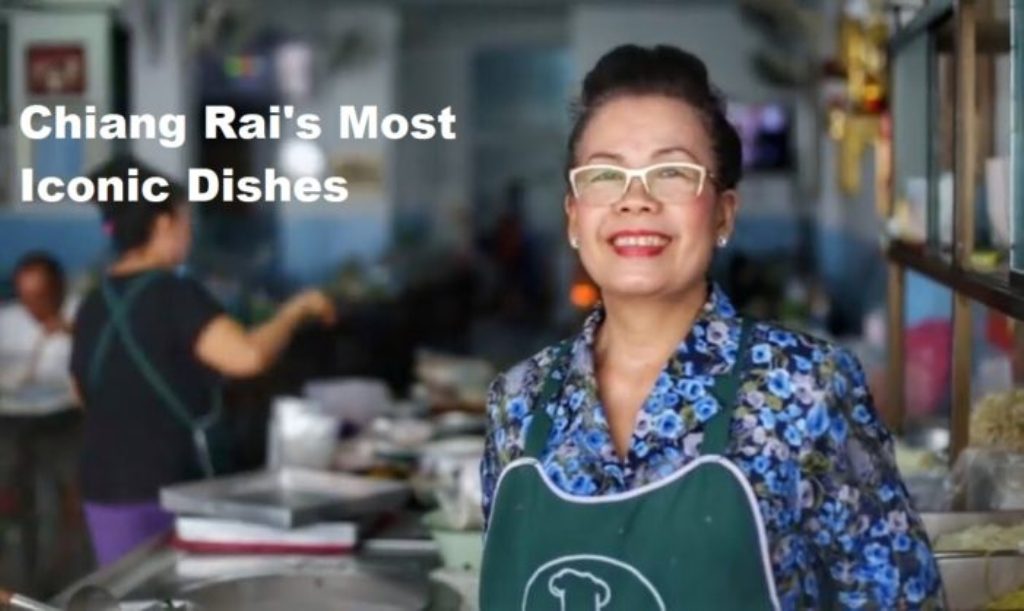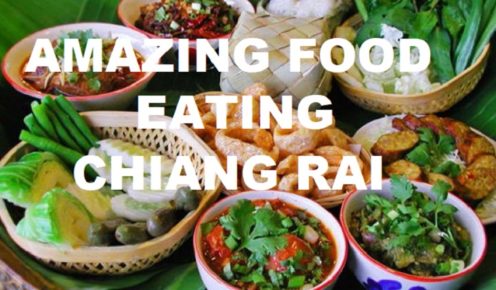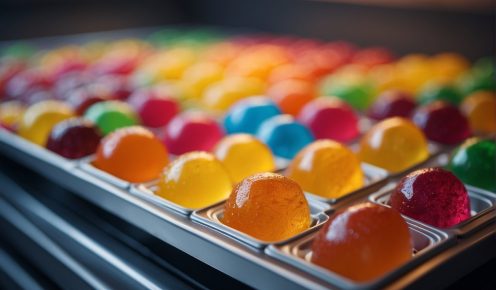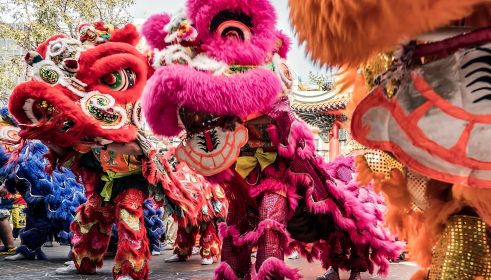CHIANG RAI – When it comes to Thai food, the first dishes that pop to mind are likely pad Thai, green curry, and tom yum. But up north in Chiang Rai, it’s a totally different story.
Unlike more familiar Central Thai food, northern Thai food has been heavily influenced by the nearby hill tribes, as well as neighbouring countries such as Laos and Myanmar. Usually eschewing coconut milk, northern Thai foods tend to be more intense, often including ingredients such as cinnamon, star anise, soya beans, lemongrass, chili and fish sauce.
To soak up the complex sauces, most noodle and curry staples typically arrive with a plate of fresh herbs, sticky rice, or fresh rice noodles. “More so than other regions in Thailand, we tend to eat rice with everything—especially sticky rice,” says Chef Pisan Thorpet, a Chiang Mai native and head chef at the Four Seasons Tented Camp in the Golden Triangle. “There is a famous phrase ‘khup kao’ which literally translates to ‘rice with anything.’”
Khanom Jeen Nam Ngiao

A homey noodle soup unique to northern Thailand, khanom jeen nam ngiao is one of the easiest dishes to find around town. Served with fresh rice noodles, this hearty stew is more like a fatty soup than a curry. Thankfully, crispy pork rinds are almost always on hand to sop up the savoury juices. The base is made from a spicy curry paste and pork broth, and then chunks of ground pork, dried herbs, tomatoes, and cubes of congealed blood are added. To make it your own, add a handful of bean sprouts for a crunchier texture or a spritz of lime to play up the acidity.
Where to try it: Paa Suk (Thanon Pakhun)—affectionately nicknamed Aunty Suk—makes the most famous khanom jeen nam ngiao in Chiang Rai. Serving up just four signature dishes, including both pork and beef nam ngiao, the tiny outfit is known to draw long lines at lunchtime. To avoid the crowds, head there first thing in the morning and dip into a fresh cauldron of pork stew. But do note, the cafe closes at 3:00pm on the dot.
Sai Ua

One of the easiest introductions to northern Thai food is ubiquitous sai ua—aka northern Thai sausage. These meaty coils are a far cry from your average hot dog, featuring a combination of aromatic herbs such as lemongrass, kaffir lime leaves, and galangal—a root from the ginger family. A bit of turmeric gives the sausage a yellow hue, while chili paste adds a subtle touch of heat.
Where to try it: Nearly every street stall and café has its own variety of northern Thai sausage, but one restaurant is said to be the top producer. For a relaxed alfresco atmosphere and a long list of grilled bites, head to Salungkham. The alfresco restaurant is low-key and inviting, with picnic tables set up in a back garden. Grilled meats—including pork ribs and chicken—are a specialty, and the sai ua is not to be missed.
Gaeng Ho

Traditionally an easy, throw-together dish made from leftovers, gaeng ho—also kaeng ho—is a homestyle stir-fry dish that combines pork, bamboo shoots, kaffir lime leaves, lemongrass, chili paste, crispy vegetables and anything else on hand, all served over a mountain of glass noodles. The dish is typically served with a side of homemade chili paste, so you can add the heat to your liking.
Where to try it: Built under a thatched-roof pavilion, Nong Yao Restaurant at the Four Seasons Tented Camp Golden Triangle offers one of the most luxurious Thai culinary experiences in the area. Offering a mix of northern Thai dishes on his menu, Chef Thorpet’s gaeng ho incorporates homemade chili paste and fresh vegetables from the hotel’s garden.
Gaeng Hang Lay

If you’re an apprehensive eater, pork and ginger curry is a safe place to start. But instead of a heavy coconut milk curry, the Lanna-style dish tastes more like a slow-cooked masala stew. Mix together big chunks of fall-apart pork belly, turmeric, lemongrass, galangal, coriander, garlic, peanuts, and a handful of fresh ginger on top—and this curry sings.
Where to try it: Stop into Chivit Thamma Da, just north of the city center. Sourcing ingredients from local producers, the family-run bistro has a sun-soaked spot on the banks of the Kok River and a charming outdoor seating area.
Kaeng Khanun

Also known as jackfruit curry, kaeng khanun soup is usually available in the springtime, starting around March. If the timing works out, jackfruit curry is worth a try. This healthy soup is relatively light, incorporating pork, cherry tomatoes, lemongrass, galangal and, of course, giant chunks of jackfruit. The result is a slightly sour, subtly spicy soup that’s not unlike the more familiar tom yum.
Where to try it: Stretching across a prime spot of real estate along the Kok River, Lu Lam Restaurant offers plenty of space to spread out. The enormous menu covers everything from local favourites like jackfruit curry to wild boar, ostrich and fried insects.
Nam Prik Ong

Akin to a salsa or a dip, nam prik ong is made with dried chilies, jalapenos, fish sauce, cilantro, tomatoes and ground pork. Once blended together the thick consistency is a bit like guacamole. Served alongside a large plate of cabbage, cucumber green beans and often deep-fried pork rinds—this is a delicious way to kicks off a casual Thai meal. There’s a vegetarian-friendly variety too, called nam prik noom, which is made from young green peppers, garlic and shallots.
Where to try it: You can find these staple dips everywhere, from the night markets to street side food stalls. We found one of the more photogenic versions at Lu Lam Restaurant, which serves a fresh spread of cabbage, green beans, cucumbers and pork rinds—encircling an addictive bowl of nam prik ong.
Laap Moo

This isn’t a typical minced pork dish. Fried up with local spices, Chiang Rai-style laap moo is an homage to pork—consisting of everything from skin, offal, and coagulated blood to kidneys, lean meat and liver. Paired with sticky rice and fresh herbs, laap moo diverges from the more typical sweet-and-sour Thai flavours, instead cultivating a heady, intense sauce that’s thickened with pork blood.
Where to try it: An outdoor café with a no-frills setup and a handy picture menu, Lab Sanam Keela is on the east side of town, near Le Meridien Hotel. It’s known as one of the best local restaurants in Chiang Rai and, while it’s not going to win any prizes for decor, the café’s thick and intense laap moo won’t disappoint.
Khao Soi

Perhaps the most famous northern Thai dish is also the most colourful—khao soi is a rich yellow chicken curry that begs to be photographed. Each big bowl is full of thick yellow egg noodles and topped with a towering crown of crispy fried noodles, making for a hearty meal. Originated in Myanmar, the dish typically arrives with a side of pickled cabbage and sliced red onion, and optional crackling pork rinds to sop up the creamy curry sauce.
Where to try it: The eponymous Khao Soi Phor Jai specialises, unsurprisingly, in khao soi. Veering from the normal lineup, the restaurant offers an unconventional option of shrimp and fish khao soi, as well as more traditional chicken. It’s a bit hard to find this cafe as there’s no English sign, but a bright blue interior and an outdoor stall selling sausage should tip you off.












